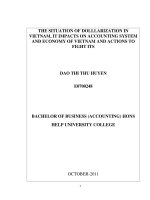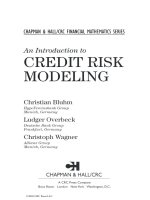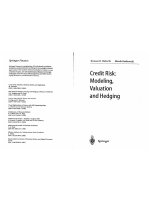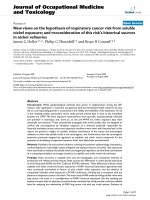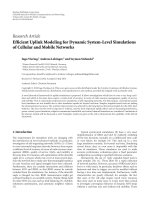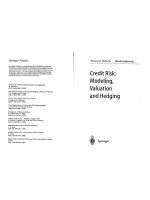Corporate credit risk modeling quantitative rating system and probability of default estimation
Bạn đang xem bản rút gọn của tài liệu. Xem và tải ngay bản đầy đủ của tài liệu tại đây (580.39 KB, 70 trang )
CORPORATE CREDIT RISK MODELING: QUANTITATIVE
RATING SYSTEM AND PROBABILITY OF DEFAULT
ESTIMATION
João Eduardo Fernandes*
April 2005
ABSTRACT: The literature on corporate credit risk modeling for privately-held firms is
scarce. Although firms with unlisted equity or debt represent a significant fraction of
the corporate sector worldwide, research in this area has been hampered by the
unavailability of public data. This study is an empirical application of credit scoring
and rating techniques applied to the corporate historical database of one of the major
Portuguese banks. Several alternative scoring methodologies are presented,
thoroughly validated and statistically compared. In addition, two distinct strategies for
grouping the individual scores into rating classes are developed. Finally, the
regulatory capital requirements under the New Basel Capital Accord are calculated for
a simulated portfolio, and compared to the capital requirements under the current
capital accord.
KEYWORDS: Credit Scoring, Credit Rating, Private Firms, Discriminatory Power,
Basel Capital Accord, Capital Requirements
JEL CLASSIFICATION: C13, C14, G21, G28
*
Correspondence Address: R. Prof. Francisco Gentil, E1 5E, 1600-625 Lisbon Portugal, email:
1
Introduction
The credit risk modeling literature has grown extensively since the seminal work by
Altman (1968) and Merton (1974). Several factors contributed for an increased
interest from the market practitioners to have a more correct assessment of the credit
risk of their portfolios: the European monetary union and the liberalization of the
European capital markets combined with the adoption of a common currency,
increased liquidity and competition in the corporate bond market. Credit risk has thus
become a key determinant of different prices in the European government bond
markets. At a worldwide level, historically low nominal interest rates have made the
investors seek the high yield bond market, forcing them to accept more credit risk.
Furthermore, the announced revision of the Basel capital accord1 will set a new
framework for banks to calculate regulatory capital. As it is already the case for
market risks, banks will be allowed to use internal credit risk models to determine
their capital requirements. Finally, the surge in the credit derivatives market has also
increased the demand for more sophisticated models.
Presently there are three main approaches to credit risk modeling. For firms with
traded equity and/or debt, Structural models or Reduced-Form models are considered.
Structural Models are based on the work of Black and Scholes (1973) and Merton
(1974). Under this approach, a credit facility is regarded as a contingent claim on the
value of the firm’s assets, and is valued according to option pricing theory. A
diffusion process is assumed for the market value of the firm and default is set to
occur whenever the estimated value of the firm hits a pre-specified default barrier.
Black & Cox (1976) and Longstaff & Schwartz (1993) have extended this framework
relaxing assumptions on default barriers and interest rates.
For the second and more recent approach, the Reduced-Form or Intensity models,
there is no attempt to model the market value of the firm. Time of default is modeled
directly as the time of the first jump of a Poisson process with random intensity.
1
For more information see Basel Committee on Banking Supervision (2003).
1
1. INTRODUCTION
2
These models were first developed by Jarrow & Turnbull (1995) and Duffie &
Singleton (1997).
For privately held firms, where no market data is available, accounting-based credit
scoring models are usually applied. Since most of the credit portfolios of commercial
banks consist of loans to borrowers in such conditions, these will be the type of
models considered in this research. Although credit scoring has well known
disadvantages2, it remains as the most effective and widely used methodology for the
evaluation of privately-held firms’ risk profiles.
The corporate credit scoring literature as grown extensively since Beaver (1966) and
Altman (1968) proposed the use of Linear Discriminant Analysis (LDA) to predict
firm bankruptcy. On the last decades, discrete dependent variable econometric
models, namely logit or probit models, have been the most popular tools for credit
scoring. As Barniv and McDonald (1999) report, 178 articles in accounting and
finance journals between 1989 and 1996 used the logit model. Ohlson (1980) and
Platt & Platt (1990) present some early interesting studies using the logit model. More
recently Laitinen (1999) used automatic selection procedures to select the set of
variables to be used in logistic and linear models which then are thoroughly tested
out-of-sample. The most popular commercial application using logistic approach for
default estimation is the Moody’s KMV RiskCalc Suite of models developed for
several countries3. Murphy et al (2002) presents the RiskCalc model for Portuguese
private firms. In recent years, alternative approaches using non-parametric methods
have been developed. These include classification trees, neural networks, fuzzy
algorithms and k-nearest neighbor. Although some studies report better results for the
non-parametric methods, such as in Galindo & Tamayo (2000) and Caiazza (2004), I
will only consider logit/probit models since the estimated parameters are more
intuitive, easily interpretable and the risk of over-fitting to the sample is lower.
Altman, Marco & Varetto (1994) and Yang et al (1999) present some evidence, using
several types of neural network models, that these do not yield superior results than
the classical models. Another potential relevant extension to traditional credit
modeling is the inference on the often neglected rejected data. Boyes et al (1989) and
Jacobson & Roszbach (2003) have used bivariate probit models with sequential events
2
3
See, for example, Allen (2002).
See Dwyer et al (2004).
1. INTRODUCTION
3
to model a lender’ decision problem. In the first equation, the decision to grant the
loan or not is modeled and, in the second equation, conditional on the loan having
been provided, the borrowers’ ability to pay it off or not. This is an attempt to
overcome a potential bias that affects most credit scoring models: by considering only
the behavior of accepted loans, and ignoring the rejected applications, a sample
selection bias may occur. Kraft et al (2004) derive lower and upper bounds for criteria
used to evaluate rating systems assuming that the bank storages only data of the
accepted credit applicants. Despite the findings in these studies, the empirical
evidence on the potential benefits of considering rejected data is not clear, as
supported in Crook & Banasik (2004).
The first main objective of this research is to develop an empirical application of
credit risk modeling for privately held corporate firms. This is achieved through a
simple but powerful quantitative model built on real data drawn randomly from the
database of one of the major Portuguese commercial banks. The output of this model
will then be used to classify firms into rating classes, and to assign a probability of
default for each one of these classes. Although a purely quantitative rating system is
not fully compliant with the New Basel Capital Accord (NBCA)4, the methodology
applied could be regarded as a building block for a fully compliant system.
The remainder of this study is structured as follows: Section 2 describes the data and
explains how it was extracted from the bank’s database;
Section 3 presents the variables considered and their univariate relationship with the
default event. These variables consist of financial ratios that measure Profitability,
Liquidity, Leverage, Activity, Debt Coverage and Productivity of the firm. Factors
that exhibit a weak or unintuitive relationship with the default frequency will be
eliminated and factors with higher predictive power for the whole sample will be
selected;
Section 4 combines the most powerful factors selected on the previous stage in a
multivariate model that provides a score for each firm. Two alternatives to a simple
4
For example, compliant rating systems must have two distinct dimensions, one that reflects the risk of
borrower default and another reflecting the risk specific to each transaction (Basel Committee on
Banking Supervision 2003, par. 358). The system developed in this study only addresses the first
dimension. Another important drawback of the system presented is the absence of human judgment.
Results from the credit scoring models should be complemented with human oversight in order to
account for the array of relevant variables that are not quantifiable or not included in the model (Basel
Committee on Banking Supervision 2003, par. 379).
1. INTRODUCTION
4
regression will be tested. First, a multiple equation model is presented that allows for
alternative specifications across industries. Second, a weighted model is developed
that balances the proportion of regular and default observations on the dataset, which
could be helpful to improve the discriminatory power of the scoring model, and to
better aggregate individual firms into rating classes;
Section 5 provides validation and comparison of the models presented in the previous
section. All considered models are screened for statistical significance, economic
intuition, and efficiency (defined as a parsimonious specification with high
discriminatory power);
In Section 6 two alternative rating systems are developed, using the credit scores
estimates from the previous section. A first alternative will be to group individual
scores into clusters, and a second to indirectly derive rating classes through a mapping
procedure between the resulting default frequencies and an external benchmark;
Section 7 derives the capital requirements for an average portfolio under the NBCA,
and compares them to the results under the current capital accord.
2
Data Considerations
A random sample of 11.000 annual, end-of-year corporate financial statements was
extracted from the financial institution’s database. These yearly statements belong to
4.567 unique firms, from 1996 to 2000, of which 475 have had at least one defaulted5
loan over a given year.
Furthermore, a random sample of 301 observations for the year 2003 was extracted in
order to perform out-of-time / out-of-sample testing. About half of the firms in this
testing sample are included in the main sample, while the other half corresponds to
new firms. In addition, it contains 13 defaults, which results in a similar default ratio
to that of the main sample (about 5%). Finally, the industry distribution is similar to
the one in the main sample (see Figure 2 below).
Due to the specificity of their financial statements, firms belonging to the financial or
real-estate industries were not considered. Furthermore, due to their non-profit nature,
firms owned by public institutions were also excluded.
The only criteria employed when selecting the main dataset was to obtain the best
possible approximation to the industry distribution of the Portuguese economy. The
objective was to produce a sample that could be, as best as possible, representative of
the whole economy, and not of the bank’s portfolio. If this is indeed the case, then the
results of this study can be related to a typical, average credit institution operating in
Portugal.
Figure 1 shows the industry distribution for both the Portuguese economy6 and for the
study dataset. The two distributions are similar, although the study sample has a
higher concentration on industry D – Manufacturing, and lower on H – Hotels &
Restaurants and MNO – Education, Health & Other Social Services Activities.
5
A loan is considered defaulted if the client missed a principal or interest payment for more than 90
days.
6
Source: INE 2003.
5
2. DATA CONSIDERATIONS
6
45%
40%
35%
30%
25%
20%
15%
10%
5%
0%
A
B
C
D
E
F
Portuguese Economy
G
H
I
K
MNO
Main Sample Data
Figure 1 – Economy-Wide vs. Main Sample Industry Distribution
Figures 2, 3 and 4 display the industry, size (measured by annual turnover) and yearly
distributions respectively, for both the default and non-default groups of observations
of the dataset.
45%
40%
35%
30%
25%
20%
15%
10%
5%
0%
A
B
C
D
Main Sample - Regular
E
F
G
Main Sample - Defaults
H
I
K
Testing Sample - Total
Figure 2 – Sample Industry Distribution
MNO
2. DATA CONSIDERATIONS
7
35%
30%
25%
20%
15%
10%
5%
0%
1996
1997
1998
Main Sample - Regular
1999
Main Sample - Defaults
2000
Main Sample - Totals
Figure 3 – Accounting Statement Yearly Distribution
20%
18%
16%
14%
12%
10%
8%
6%
4%
2%
0%
1
2
3
4
5
6
Sample Data - Regulars
7
10
15
20
Sample Data - Defaults
30
40
50
60
70
More
Sample Data - Totals
Figure 4 – Size (Turnover) Distribution, Millions of Eur
Analysis of industry distribution (Figure 2) suggests high concentration on industries
G – Trade and D – Manufacturing, both accounting for about 75% of the whole
sample. The industry distributions for both default and non-default observations are
very similar.
Figure 3 presents more uniformly distributed observations per year, for the last three
periods, with about 3.000 observations per year. For the regular group of
observations, the number of yearly observations rises steadily until the third period,
and the remains constant until the last period. For the default group, the number of
2. DATA CONSIDERATIONS
8
yearly observations has a great increase in the second period and clearly decreases in
the last.
Regarding size distribution, analysis of Figure 4 indicates that most of the
observations belong to the Small and Medium size Enterprises - SME segment, with
annual turnover up to 40 million Eur. The SME segment accounts for about 95% of
the whole sample. The distributions of both regular and default observations are very
similar.
3
Financial Ratios and Univariate Analysis
A preliminary step before estimating the scoring model will be to conduct an
univariate analysis for each potential input, in order to select the most intuitive and
powerful variables. In this study, the scoring model will consider exclusively financial
ratios as explanatory variables. A list of twenty-three ratios representing six different
dimensions – Profitability, Liquidity, Leverage, Debt Coverage, Activity and
Productivity – will be considered. The univariate analysis is conducted between each
of the twenty-three ratios and a default indicator, in order to assess the discriminatory
power of each variable. Appendix 1 provides the list of the considered variables and
their respective formula. Figures 5 to 10 provide a graphical description, for some
selected variables, of the relationship between each variable individually and the
default frequency7.
6%
Default Frequency
5%
4%
3%
2%
0%
10%
20%
30%
40%
50%
60%
70%
80%
90%
100%
Percentile
Figure 5 – Univariate Relationship Between Variable R7 and Default Frequency
7
The data is ordered ascendingly by the value of each ratio and, for each decile, the default frequency
is calculated (number of defaults divided by the total number of observations in each decile).
9
3. FINANCIAL RATIOS AND UNIVARIATE ANALYSIS
10
Default Frequency
6%
5%
4%
3%
0%
10%
20%
30%
40%
50%
60%
70%
80%
90%
100%
Percentile
Figure 6 – Univariate Relationship Between Variable R8 and Default Frequency
6%
Default Frequency
5%
4%
3%
2%
0%
10%
20%
30%
40%
50%
60%
70%
80%
90%
Percentile
Figure 7 – Univariate Relationship Between Variable R9 and Default Frequency
100%
3. FINANCIAL RATIOS AND UNIVARIATE ANALYSIS
11
8%
Default Frequency
7%
6%
5%
4%
3%
2%
1%
0%
10%
20%
30%
40%
50%
60%
70%
80%
90%
100%
Percentile
Figure 8 – Univariate Relationship Between Variable R17 and Default Frequency
12%
11%
10%
Default Frequency
9%
8%
7%
6%
5%
4%
3%
2%
1%
0%
0%
10%
20%
30%
40%
50%
60%
70%
80%
90%
Percentile
Figure 9 – Univariate Relationship Between Variable R20 and Default Frequency
100%
3. FINANCIAL RATIOS AND UNIVARIATE ANALYSIS
12
8%
Default Frequency
7%
6%
5%
4%
3%
2%
0%
10%
20%
30%
40%
50%
60%
70%
80%
90%
100%
Percentile
Figure 10 – Univariate Relationship Between Variable R23 and Default Frequency
In order to have a quantitative assessment of the discriminating power of each
variable, the Accuracy Ratio8 was used. The computed values of the Accuracy Ratios
are reported in Appendix 1.
The variables selected for the multivariate analysis comply with the following criteria:
-
They must have discriminating power, with an Accuracy Ratio higher than
5%;
-
The relationship with the default frequency should be clear and economically
intuitive. For example, ratio 3 should have a negative relationship with the
default frequency, since firms with a high percentage of EBITDA over
Turnover should default less frequently. Analyzing Figure 11, there seems to
be no clear relationship for this dataset;
-
The number of observations lost due to lack of information on any of the
components of a given ratio must be insignificant. Not all firms report the
exact same items on their accounting reports, for example, ratios 12 and 18
have a significant amount of missing data for the components Debt to Credit
Institutions and Long-Term Liabilities respectively.
8
See Section 5.1 for a description of the Accuracy Ratio.
3. FINANCIAL RATIOS AND UNIVARIATE ANALYSIS
13
6%
Default Frequency
5%
5%
4%
4%
3%
0%
10%
20%
30%
40%
50%
60%
70%
80%
90%
100%
Percentile
Figure 11 – Univariate Relationship Between Variable R3 and Default Frequency
At this point, nine variables were eliminated and will not be considered on the
multivariate analysis. All the remaining variables were standardized in order to avoid
scaling issues.
4
Scoring Model
The variables selected on the previous stage were pooled together in order to obtain a
model that is at the same time:
-
Parsimonious but powerful: high discriminating power with few parameters to
estimate;
-
Statistically significant: all variables individually and the model as a whole
must be significant, with low correlation between the variables;
-
Intuitive: the sign of the estimated parameters should make economic sense
and the selected variables should represent the various relevant risk factors.
Using both forward and backward procedures, the selected model is the one that
complies with the above criteria and has the higher discriminating power, measured
by the Accuracy Ratio.
The dependent variable Yit of the model is the binary discrete variable that indicates
whether firm i has defaulted or not in year t. The general representation of the model
is:
Yit = f ( β k , X itk−1 ) + eit
where X itk−1 represents the values of the k explanatory variables of firm i, one year
before the evaluation of the dependent variable. The functional form selected for this
study was the Logit model9. Alternative specifications could be considered, such as
Probit, Linear Probability Model or even Genetic Algorithms, though there is no
evidence in the literature that any alternative specification can consistently outperform
the Logit specification in credit default prediction (Altman, Marco & Varetto 1994
and Yang et al 1999).
During the model estimation two hypotheses were tested:
1. Whether a system of unrelated equations, by industry group yields better
results than a single-equation model for all industries;
9
Refer to Appendix 3 for a description of the Logit model.
14
4. SCORING MODEL
15
2. Whether a model where the observations are weighted in order to increase the
proportion of defaults to regulars in the estimation sample, performs better
than a model with unweighted observations.
4.1
Multiple Industry Equations vs. Single Equation Model
In order to test this hypothesis, the dataset was broken into two sub-samples: the first
one for Manufacturing & Primary Activity firms, with 5.046 observations of which
227 are defaults; and the second for Trade & Services firms, with 5.954 observations
and 248 defaults. If the nature of these economic activities has a significant and
consistent impact on the structure of the accounting reports, then it is likely that a
model accommodating different variables for the different industry sectors performs
better10 than a model which forces the same variables and parameters to all firms
across industries. The estimated models are:
exp ( µˆ i )
Yˆi =
1 + exp ( µˆ i )
For the two-equation model,
⎧⎪ X i ' βˆI
ˆ
⎩⎪ X i ' β II
µˆ i = ⎨
if i belongs to industry I
if i belongs to industry II
For the single-equation model,
µˆ i = X i ' βˆ
∀i
For the final model, the selected variables and estimated coefficients are presented in
the table below11:
10
Model performance is measured by the ability to discriminate between default and regular
populations, which can be summarized by the Accuracy Ratio.
11
Refer to Appendix 4 for full estimation results.
4. SCORING MODEL
Two-Equation Model (A)
Industry I
Industry II
Variable
β^
Variable
β^
R7
-0.381 R8
-0.212
R17
-0.225 R9
-0.160
R20_1
2.011 R17
-0.184
R20_2
-0.009 R20_1
1.792
R23
0.200 R20_2
-0.009
K
-3.259 K
-3.426
-
16
Single-Equation
Model (B)
Variable
β^
R8
-0.171
R9
-0.211
R17
-0.231
R20_1
1.843
R20_2
-0.009
R23
0.124
K
-3.250
Table 1 – Estimated Model Variables & Parameters, Models A & B
The estimated Accuracy Ratio for the two-equation model is 43,75%, which is
slightly worse than the Accuracy Ratio of the single-equation model, 43,77%12. The
out-of-sample results confirm this tendency, the AR of the two-equation model is
46,07%, against 50,59% of the single-equation model although, as shown latter, this
difference is not statistically significant.
Since the two-equation model involves more parameters to estimate and is not able to
better discriminate to a significant extent the default and regular populations of the
dataset, the single-equation specification is considered superior in terms of scoring
methodology for this dataset.
4.2
Weighted vs. Unweighted Model
The proportion of the number of defaults (450) to the total number of observations in
the sample (11.000) is artificially high. The real average annual default frequency of
the bank’s portfolio and the Portuguese economy is significantly lower than the 4,32%
suggested by the sample for the corporate sector. However, in order to be able to
correctly identify the risk profiles of “good” and “bad” firms, a significant number of
observations for each population is required. For example, keeping the total number
of observations constant, if the correct default rate was about 1%, extracting a random
sample in accordance to this ratio would result in a proportion of 110 default
observations to 11.000 observations.
12
A statistical test to compare the Accuracy Ratios for all estimated models is applied in Section 5.1.
4. SCORING MODEL
17
A consequence of having an artificially high proportion of default observations is that
the estimated scores cannot be directly interpreted as real probabilities of default.
Therefore, these results have to be calibrated in order to obtain default probabilities
estimates.
A further way to increase the proportion of the number of default observations is to
attribute different weights to the default and regular observations. The weightening of
observations could potentially have two types of positive impact in the analysis:
1. As mentioned above, a more balanced sample, with closer proportions of
defaults and regular observations, could help the Logit regression to better
discriminate between both populations;
2. The higher proportion of default observations results in higher estimated
scores. As a consequence, the scores in the weighed model are more evenly
spread throughout the ]0,1[ interval (see Figure 12). If, in turn, these scores are
used to group the observations into classes, then it could be easier to identify
coherent classes with the weighed model scores. Thus, even if weightening the
observations does not yield a superior model in terms of discriminating power,
Observation
it might still be helpful later in the analysis, when building the rating classes.
0%
10%
20%
30%
40%
50%
60%
70%
80%
90%
100%
Score
Unw eighted Model Score
Weighted Model Score
Figure 12 – Weighted vs. Unweighted Score
The weighed model estimated considers a proportion of one default observation for
two regular observations. The weighed sample consists of 1425 observations, of
4. SCORING MODEL
18
which 475 are defaults and the remaining 950 are regular observations13. The
optimized model selects the same variables has the unweighted model though with
different estimated coefficients:
Weighted Model (C)
Unweighted Model (B)
Variable
R8
R9
B
Variable
-0.197 R8
-0.223 R9
B
-0.171
-0.211
R17
-0.203 R17
-0.231
R20_1
1.879 R20_1
1.843
R20_2
-0.009 R20_2
-0.009
R23
0.123 R23
0.124
K
-0.841 K
-3.250
Table 2 – Estimated Model Variables & Parameters, Models B & C
The estimated Accuracy Ratio for the weighed model is 43,74%, marginally worse
than the 43,77% of the unweighted model. Again, the out-of-sample results confirm
that the weighted model does not have a higher discriminating power (AR of 48,29%)
than the unweighted model (AR of 50,59%).
The following section analyses the validation and comparison of the different
estimated models in more detail.
13
Other proportions were tested yielding very similar results.
5
Model Validation
As mentioned before, all three models – the two-equation model (Model A), the
single-equation unweighted model (Model B) and the single-equation weighed model
(Model C) – should be, at the same time, efficient, statistically significant and
intuitive.
5.1
Efficiency
All three models have a small number of selected variables: Model A five variables
for each equation, and models B and C six variables each. A model with high
discriminatory power is a model that can clearly distinguish the default and nondefault populations. In other words, it is a model that makes consistently “good”
predictions relative to few “bad” predictions. For a given cut-off value14, there are two
types of “good” and “bad” predictions:
Observed
Estimated
Non-Default
Default
Non-Default
True
False Alarm
(Type II Error)
Default
Miss (Type I
Error)
Hit
The “good” predictions occur if, for a given cut-off point, the model predicts a default
and the firm does actually default (Hit), or, if the model predicts a non-default and the
firm does not default in the subsequent period (True).
The “bad” prediction occurs if, for a given cut-off point, the model predicts a default
and the firm does not actually defaults (False-Alarm or Type II Error), or if the model
predicts a non-default and the firm actually defaults (Miss or Type I Error).
14
The cut-off point is the value from which the observations are classified as “good” or “bad”. For
example, given a cut-off point of 50%, all observations with an estimated score between 0% and 50%
will be classified as “good”, and those between 50% and 100% will be considered “bad”.
19
5. MODEL VALIDATION
20
The Hit Ratio (HR) corresponds to the percentage of defaults from the total default
population that are correctly predicted by the model, for a given cut-off point.
The False Alarm Ratio (FAR) is the percentage of False Alarms or incorrect default
predictions from the total non-defaulting population, for a given cut-off point.
Several alternatives could have been considered in order to analyze the discriminating
power of the estimated models. In this study, both ROC/CAP analysis and
Kolmogorov-Smirnov (KS) analysis were performed:
Receiver Operating Characteristics (ROC) and Cumulative Accuracy Profiles (CAP)
curves are two closely related graphical representations of the discriminatory power of
a scoring system. Using the notation from Sobehart & Keenan (2001), the ROC curve
is a plot of the HR against the FAR, while the CAP curve is a plot of the HR against
the percentage of the sample.
For the ROC curve, a perfect model would pass through the point (0,1) since it always
makes “good” predictions, and never “bad” predictions (it has FAR = 0% and a HR =
100% for all possible cut-off points). A “naïve” model is not able to distinguish
defaulting from non-defaulting firms, thus will do as many “good” as “bad”
predictions, though for each cut-off point, the HR will be equal to the FAR. A better
model would have a steeper curve, closer to the perfect model, thus a global measure
of the discriminant power of the model would be the area under the ROC curve. This
can be calculated has15:
1
AUROC = ∫ HR( FAR) d ( FAR)
0
For the CAP or Lorenz curve, a perfect model would attribute the lowest scores to all
the defaulting firms, so if x% of the total population are defaults, then the CAP curve
of a perfect model would pass through the point (x,1). A random model would make
as many “good” as “bad” predictions, so for the y% lowest scored firms it would have
a HR of y%. Then, a global measure of the discriminant power of the model, the
Accuracy Ratio (AR), compares the area between the CAP curve of the model being
tested and the CAP of the random model, against the area between the CAP curve of
the perfect model and the CAP curve of the random model.
15
Refer to Appendix 2 for a technical description of the AUROC calculation.
5. MODEL VALIDATION
21
It can be shown16 that there is a linear relationship between the global measures
resulting from the ROC and CAP curves:
AR = 2* ( AUROC − 0.5 )
The KS methodology17 considers the distance between the distributions of 1 – HR (or
Type I Errors) and 1 – FAR (or True predictions). The higher the distance between the
two distributions, the better the discriminating power of the model. The KS statistic
corresponds to the maximum difference for any cut-off point between the 1 – FAR
and 1 – HR distributions.
Analyzing Figures 13 to 20, we can conclude that all three models have significant
discriminating power and have similar performances. Results for Altman’s Z’-Score
Model for Private Firms (Altman 2000) are also reported as a benchmark (Model D):
100%
90%
80%
70%
HR
60%
50%
40%
30%
20%
10%
0%
0%
10%
20%
30%
40%
50%
60%
70%
80%
90%
100%
FAR
Model A
Model B
Model C
Model D
Random Model
Figure 13 – Receiver Operating Characteristics Curves
16
See, for example, Engelmann, Hayden & Tasche (2003).
The Kolmogorov-Smirnov statistic is a non-parametric statistic used to test whether the density
function of a variable is the same for two different groups (Conover 1999).
17
5. MODEL VALIDATION
22
100%
90%
80%
70%
HR
60%
50%
40%
30%
20%
10%
0%
0%
10%
20%
30%
40%
50%
60%
70%
80%
90%
100%
% of Sam ple
Perfect Model
Model A
Model B
Model C
Model D
Radom Model
Figure 14 – Cumulative Accuracy Profiles Curves
100%
90%
Cummulative Frequency
80%
70%
60%
50%
40%
30%
20%
10%
0%
0%
5%
10%
15%
20%
25%
Score %
1-FAR (1-Type II Error)
1-HR (Type I Error)
Figure 15 – Model A: Kolmogorov-Smirnov Analysis
30%
35%
5. MODEL VALIDATION
23
100%
90%
80%
70%
Error, %
60%
50%
40%
30%
20%
10%
0%
0%
5%
10%
15%
20%
25%
30%
35%
30%
35%
Score, %
1-HR (Type I)
FAR (Type II)
Figure 16 – Model A: Types I & II Errors
100%
90%
Cummulative Frequency
80%
70%
60%
50%
40%
30%
20%
10%
0%
0%
5%
10%
15%
20%
25%
Score %
1-FAR (1-Type II Error)
1-HR (Type I Error)
Figure 17 – Model B: Kolmogorov-Smirnov Analysis
5. MODEL VALIDATION
24
100%
90%
80%
70%
Error, %
60%
50%
40%
30%
20%
10%
0%
0%
5%
10%
15%
20%
25%
30%
35%
Score, %
1-HR (Type I)
FAR (Type II)
Figure 18 – Model B: Types I & II Errors
100%
90%
Cummulative Frequency
80%
70%
60%
50%
40%
30%
20%
10%
0%
0%
10%
20%
30%
40%
50%
60%
70%
Score %
1-FAR (1-Type II Error)
1-HR (Type I Error)
Figure 19 – Model C: Kolmogorov-Smirnov Analysis
80%
90%

